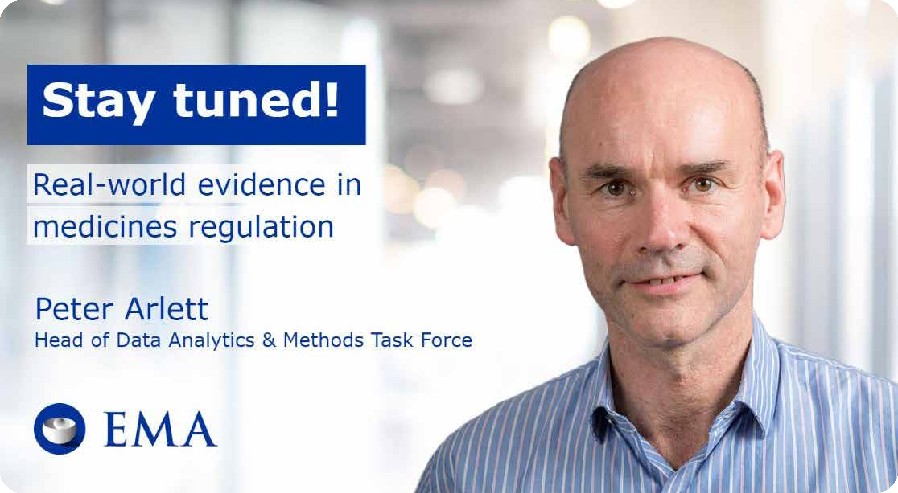
Better data to translate innovation into medicines
Data underpin everything in healthcare and fuel the decisions regulators take every day. The evidence we gather from analysing data is how we can tell whether a medicine works and whether it is safe, how the balance of benefits and risks is weighed. In 2023, new possibilities for data-driven decision-making surfaced that have the potential to transform medicines regulation.
With emerging technologies such as artificial intelligence (AI) and machine learning, a much more proactive and responsive regulatory system is within view. These digital advancements make it possible to use data in new ways and explore the full potential of new analytic tools to make sense of them. Traditionally, clinical trials represent the foundation of data-driven medicines regulation, but increasingly, data generated by patients and healthcare professionals as part of daily healthcare activities can complement evidence from clinical trials. This can help medicines regulators better characterise diseases, treatments and assess the benefits and risks of medicines across their entire life cycle.
In 2023, understanding how we can efficiently analyse and use data to inform medicines regulation has been a key priority for the Agency and the European medicines regulatory network (EMRN). This year was important in ensuring the EU’s regulatory system is more prepared to embrace the full potential of data. The Accelerating Clinical Trials in the EU initiative (ACT EU) is in full swing, with its workplan to 2026 published in November. At the same time, the work of the Big Data Steering Group (BDSG) continued exploring the best ways to strengthen the regulatory system by integrating data analysis into its assessment processes to improve decision making.
ACT EU and innovating clinical trials
Clinical trials are the gold standard to generate evidence about medicines. They are the cornerstone of medicines regulation and, for this reason, the Network has committed to supporting clinical research and ensuring that the EU is a global hub in this field. A dynamic and efficient clinical trial environment is an engine for development, attracting innovation and research to Europe, guaranteeing representative trials and supporting early access for European patients to new treatments.
While 2022 saw many regulatory changes to the EU clinical trials environment, like the new Clinical Trials Regulation coming into force, the rollout of the Clinical Trials Information System (CTIS) and the launch of ACT EU, 2023 was a year of consolidation. CTIS became mandatory in January, with the Agency continuing to provide support and guidance to applicants on the new system, which enables centralised submission and access to clinical data in the EU. Enabling this transition is vital, as creating streamlined infrastructures across the EU is one of the main goals of the Network, and one of the pillars of the ACT EU initiative. In addition, guidance is being updated to ensure that it reflects technological change and encourages innovation by including, for example, technologies that allow decentralised studies at patients’ homes or more powerful analytical tools.
This content is hosted by a third party. By viewing this external content, you accept the terms and conditions of youtube.com
What is Accelerating Clinical Trials in the EU (ACT EU) and how is the Network supporting innovative clinical trials?
Publishing information on clinical studies helps build trust and support clinical research. A consultation launched in May collected stakeholders’ views on how to enable timely transparency in the new CTIS. The consultation resulted in the publication of the revised CTIS transparency rules in October.
EMA and HMA organised two important occasions for exchange in 2023: in July, a workshop explored the revision of the ICH E6 guideline on the conduct of clinical trials with all relevant stakeholders and, in November, a multi-stakeholder workshop on clinical trial methodology looked at the available know-how at EU level and where further guidance is needed. In April, a reflection paper on single-arm trials was published.
None of this would be possible without a forum for discussion with all the relevant parties involved in clinical trials: from regulators and developers, to academia, healthcare professionals, patients and consumers. For this reason, 2023 also saw the creation of the ACT EU multi-stakeholder platform, which was launched in June. The platform includes representatives from all groups mentioned and meets regularly to discuss ACT EU priorities.
Keep informed about ACT EU: check out the website, launched in November
The potential of data: beyond clinical trials
Data-driven regulation goes beyond clinical trials. As noted above, the analysis of real-world data (RWD) can complement evidence from clinical trials and support regulatory decisions. In June, the publication of the first report on the use of real-world evidence in regulatory decision making was a considerable milestone towards integrating regulator-led studies using RWD in regulatory activities.
The report assessed the use of RWD in regulator-led pilot studies during an 18-month period. It highlighted areas like safety monitoring, evaluation of orphan designations, assessment of paediatric investigation plans and provision of scientific advice to developers as key areas where the generation of real-world evidence (RWE) can address knowledge gaps. Some of the studies looked at how diseases manifest in different populations, how medicines are used by patients and how patients may react to specific treatments. This can be particularly helpful when treating rare conditions or special populations like children, elderly individuals and pregnant people, that are less represented and studied in clinical trials.
Sources of real-world data: DARWIN EU
Generating data is simple. We do it every day as we sleep, eat, walk and go about our lives. But how does data get fed into regulatory decision making? How is it analysed so it can become valid and reliable evidence rather than raw, unfiltered information?
EMA has three ways to access and analyse data: 1) through direct access to several European primary healthcare databases, 2) through studies commissioned to research organisations that use more specialised sources, and 3) through a federated network of data partners known as DARWIN EU®.
DARWIN EU, which will celebrate its second year in February 2024, is a network of 20 partners from 12 EU Member States to date. Together they provide access to data from millions of patients in Europe. By the end of 2023, the initiative ran 18 studies to support the work of EMA’s committees. These studies are looking into a variety of questions: from how opioids are used in the EU, to investigating deaths and severe adverse events linked to severe asthma, and understanding the disease progression of multiple myeloma and rare conditions like dermatomyositis and polymyositis.
To ensure that we exploit the full potential of data-driven medicines regulation, the BDSG is working towards creating a framework that is ready to adapt to and exploit future innovation.
Learn more about the work of the BDSG: check out the 2023 report.
In April, EMA organised a multi-stakeholder workshop on qualification of novel technologies to discuss the first point of dialogue between regulators and developers on new technological advancements. In June, the reflection paper on proposed international harmonisation of real-world evidence terminology was published. With this paper, global regulators are taking an important step towards a more standardised use of terms such as RWD and RWE.
In December 2023, EMA finalised the Data Quality Framework for EU medicines regulation, following discussions with stakeholders, the Methodology Working Party and public consultation. This sets common standards for data sources to ensure they are accurate and reliable. The HMA-EMA Big Data Forum, an annual fixture in EMA’s calendar of events, brought all stakeholders together in December to discuss the state of play of the work towards data-driven regulation. A similar event took place in the veterinary community in November, to discuss the implementation of the Veterinary Big Data Plan to 2025 following the establishment of the Veterinary Data Hub in June.
Innovative manufacturing
Innovation is not only about development of new medicines. It’s also about how medicines are made. Ultramodern factories, quality batch-testing using AI, ‘mini-pods’ that can produce medicines for patients directly at point-of-care … How do we promote trust in the quality of all these technologies?
The Quality Innovation Group was created at the end of 2022 to support the translation of innovative approaches to the design, manufacture and quality control of medicines. Its work plan, published in February 2023, focuses on providing developers with advice from proof-of-concept through to product development, helping clarify regulatory expectations, speeding up regulatory timelines and reducing the regulatory burden. Four listen-and-learn focus groups were held with industry stakeholders this year, to understand the regulatory needs of developers. At the same time, the group met with the US FDA in November to ensure that these efforts are aligned internationally.
Embracing the opportunities of artificial intelligence
There is no doubt that 2023 was the year of artificial intelligence (AI). Everyone is starting to explore and understand how to use AI in day-to-day life, and regulators make no exception. EMA and the Network have been working to enable the potential of AI for medicines regulation and to assess its risks.
In July, EMA published a draft reflection paper outlining the current thinking on the regulatory use of AI for public consultation. This paper reflects on principles relevant to the application of AI and machine learning at any step of a medicine’s lifecycle, from drug discovery to the post-authorisation setting.
To encourage stakeholders to bring in their views on this topic, which may have important repercussions on medicines regulation at global, European and national level, a multi-stakeholder workshop was organised in November. This work led, in December, to the publication of the HMA-EMA AI Workplan that aims to ensure the Network remains at the forefront of benefiting from AI in medicines regulation.
